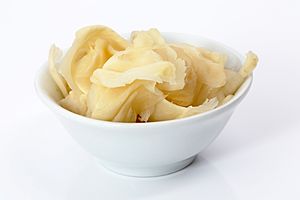Gari (ginger) facts for kids
Gari (ガリ) is a type of tsukemono, which means "pickled things" in Japanese. It is made from young, thinly sliced ginger that has been soaked in a sweet and sour liquid. This liquid is usually a mix of sugar and vinegar.
Young ginger is often chosen for gari because it is softer and tastes naturally sweeter. Gari is often served with sushi and is sometimes called sushi ginger or pickled ginger. In Japanese cooking, it is very important for how sushi is presented.
Why Eat Gari with Sushi?
Many people believe gari helps to cleanse your mouth between eating different kinds of sushi. This helps you taste each new piece clearly. Another idea is that it was first used to help protect against tiny germs that can be found on raw food.
The Color of Gari
When gari is made in the traditional way, it usually looks pale yellow or a little bit pink. Only very young ginger will naturally turn a light pink color during the pickling process.
Many brands of gari that you buy in stores are colored pink. This can be done artificially with food dyes like E124. Sometimes, natural ingredients like beet juice are used to make the pink color stronger. This is often done if the ginger used was too old to turn pink on its own.
Health Benefits
Since gari is a prepared form of ginger, it has some minor properties that can help fight off tiny germs. This can be helpful when you are eating raw foods.


